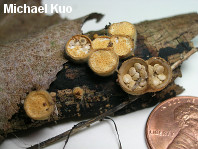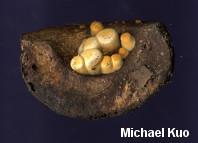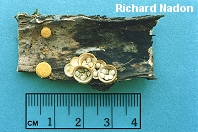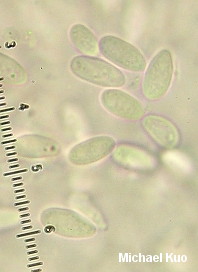| Major Groups > Bird's Nest Fungi > Crucibulum laeve |

|
Crucibulum laeve [ Basidiomycota > Agaricales > Agaricaceae > Crucibulum . . . ] by Michael Kuo Crucibulum laeve is probably the most common and frequently encountered bird's nest fungus in temperate North America. Three features serve to identify it successfully: its yellowish colors; the "lid" over the nest (in young specimens), covering the eggs; and the tiny cords that attach the eggs to the nest. Observing this last feature requires some patience with a very tiny tool--say, a needle or a pin--and a hand lens. The cord, which is called a "funiculus" in Mycologese, is the egg's mechanism for attaching itself to sticks, leaves, and other plant debris. When a raindrop falls into the nest, the eggs are projected out of the cup. As this happens, the cord is stretched to its limit--then breaks away from the nest, remaining attached to the egg. Where the cord was attached to the nest, it becomes frayed, since it was torn away. The little frayed ends are adhesive, and when they come into contact with, for example, a leaf, they attach themselves. This stops the flight of the egg, which then swings back and attaches itself to the leaf as well . . . rather like what would happen to a kite if you were to let it sail away after coating your end of the string with glue. Description: Ecology: Saprobic; growing alone, scattered, or densely gregariously on woodland debris (sticks, leaves, nutshells, needles, etc.), woodchips, old furniture, dung, and so on (but not typically on the ground alone or on larger logs); spring through fall (or in winter in warmer climates); widely distributed in North America. Nest: 2–9 mm high; 4–10 mm across; at first cushion-shaped to round, and closed by a mustard yellow to dull yellow "lid"; later becoming cup-shaped or goblet-shaped, the lid disappearing; outer surface yellowish at first, remaining yellow or darkening to nearly brown, velvety or fairly bald; inner surface bald and shiny, whitish to grayish. Eggs: To 2 mm wide; shaped like flattened circles or ellipses; tough; attached to the nest by tiny cords; pale tan to buff. Microscopic Features: Spores 6–9 x 3–5 µm; ellipsoid; smooth. REFERENCES: (Hudson, 1778) Kambly, 1936. (Saccardo, 1888; Brodie, 1975; Smith, Smith & Weber, 1981; Arora, 1986; States, 1990; Phillips, 1991/2005; Lincoff, 1992; Horn, Kay & Abel, 1993; Evenson, 1997; Barron, 1999; Roody, 2003; McNeil, 2006; Miller & Miller, 2006.) Herb. Kuo 06079601, 06300703, 06080801, 06121302. This site contains no information about the edibility or toxicity of mushrooms. |
© MushroomExpert.Com |
|
Cite this page as: Kuo, M. (2014, February). Crucibulum laeve. Retrieved from the MushroomExpert.Com Web site: http://www.mushroomexpert.com/crucibulum_laeve.html |



